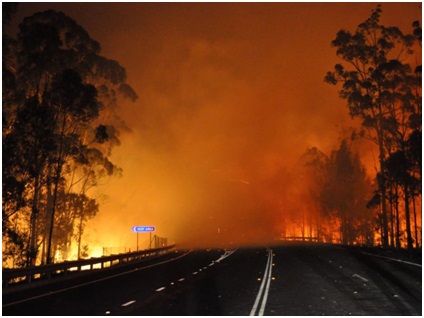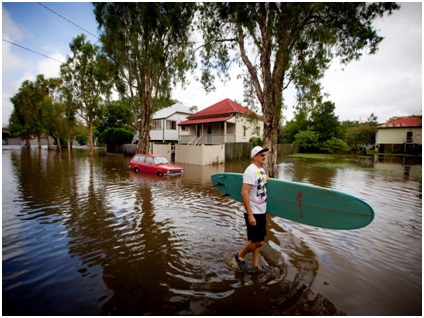In early 2012 once-in-a-century
floods submerged swaths
of Great Britain and Ireland, causing some $1.52 billion in damages. Then in
June record-high temperatures in Russia sparked wildfires that consumed
74 million acres of pristine
Siberian taiga. Months after that, Hurricane
Sandy pummeled seven
countries, killing hundreds and running up an estimated $75 billion in damages.
Just this week, a tornado of virtually unheard of size and ferocitytore
through a small city in Oklahoma, leaving 24 people
dead.
Each
of these one-off traumas was bad enough, wreaking havoc, but in Australia such
events seem to be becoming commonplace.
The
Lucky Country has experienced a major spike in extreme weather in the past few
years, with a string of devastating incidents just since January.
That
has people wondering if the island continent is somehow a perfect bellwether
for the Earth's changing climate. So scientists are bearing down on the problem
with intensity, investigating Australia's increasingly violent weather patterns
and trying to figure out what they might portend for the rest of the world as
our climate changes.
So Hot Even the Summer Got Angry
The
rough-hewn sandstone buildings perched atop Observatory Hill have been keeping
an eye on Sydney Harbor since 1858. They've pretty much seen it all—from the
installation of the city's first gaslights to the construction of the now
iconic Sydney Opera House and Harbor Bridge.
But at
2:55 p.m. on January 18, 2013, meteorological equipment in the observatory
registered something new: a read-out marking the hottest day in the
city's history:
45.8°C (114.4°F).
Much
of the continent was languishing in the grip of a heat wave that would break 123 heat and
flood-related records in 90 days—among
them, the hottest summer on record and the hottest seven consecutive days ever
recorded.
At the
time these statistical dramas, and their possible significance, paled against
the imperative of not self-combusting on your walk from office to car.
At the
Pink Roadhouse in the outback town of Oodnadatta—whose locals are
legendary for the stoicism with which they have long dealt with living in
Australia's hottest town—temperatures pushed so high that gasoline vaporized
before it even made it into the fuel tank.
 
A wildfire crosses
an Australian highway.
"The
ground, the building, everything is so hot, you walk outside and you feel it's
going to burn you," Lynnie Plate, the exhausted owner of the
establishment, told a reporter at the time.
The
national record of 50.7°C (123.2°F) set in Oodnadatta in January 1960 stayed
intact, just barely.
Australians
love their summer heat. They take particular joy in mocking British tourists
for the magenta hue they often acquire after even a mild day at the beach.
Because
winter and summer temperature variations aren't all that great in much of
Australia, Aussies, unlike the Brits, are habitually accustomed to heat that
might melt lesser mortals.
But
when 8 of the 21 days in the last 102 years on which Australia averaged a high
of more than 39°C (102°F) happened to occur in 2013, people weren't charmed.
The
anomaly stood out. Numbers like those break through what climate scientists
like David Jones, manager of climate monitoring prediction at theAustralian Bureau of Meteorology, call the "signal to noise" ratio.
"One
of the first places on the planet where the global warming signal is easy to
discern is actually Australia, because of this low temperature
variability," Jones said. "And that's exactly what we're seeing. The
Australian warming trend is very clearly apparent in our records. It pops out
quite quickly from the background noise of weather patterns."
But
just what does that breaking through the noise tell us? Apparently, it says not
to expect things to calm down any time soon.
A Continent-Size Canary?
On
January 26, before the heat wave was even over, the second round of devastating
flooding since 2011 was battering
Queensland.
The
remnants of Tropical Cyclone Oswald lashed the country's east coast, killing
six people and costing about $2.5 billion in damages. Military helicopters were
sent into the city of Bundaberg to evacuate stranded residents as the streets
churned with water, debris, and sewage.

A wallaby stands
on a hay bail, trapped by rising flood waters in Queesland.
It
could have been worse—in 2011 similar
floods killed more than 30 people and chalked up a $2.4 billion tab.
Tropical
cyclones have always been a reality of life here, but the sheer intensity of
these storms shocked the country.
Once
upon a time, once-in-a-century flooding meant just that, but these days the
term seems to be shorthand for a really bad flood.
Higher
ocean surface temperatures caused by the spiraling heat results in more
evaporation. And an atmosphere loaded with water vapor means more and heavier
rain.
Climate
scientists have long been reluctant to link individual extreme weather events
to climate change—something that's impossible to do with any scientific rigor.
They've
also been loath to speak in the aggregate about a connection. That reluctance,
however, is starting to disappear.
In
early March the Australian government's climate change watchdog, theClimate Commission, released a
bombshell of a report called "The Angry
Summer."
The
report explicitly connects Australia's recent spate of weather to climate
change.
Will
Steffen, executive director of the Australian National University Climate Change Institute and the report's author, reckoned that there was a one-in-five-hundred
chance that natural variation had caused the recent extreme events.
Although
Steffen still isn't willing to say that individual weather occurrences are the
result of climate change, he suggests that collectively they do demonstrate a
rapidly changing climate.
He
believes Australia is a unique environment in which to watch the change because
it is already such a naturally extreme place.
"We
have such a range of different types of extreme events and climatic patterns
that affect people," Steffen said. "Examples being obviously
sea-level rise, because we're a coastal country; high-temperature events; bush
fires; droughts and floods all at the same time.
"So
you've got the basket of the worst types of extreme weather events all being
fairly prominent in Australia."
The
blistering 2013 heat wave started out in the parched, largely empty, red center
of the continent and spread to the east coast.
Roughly
80 percent of Australians live within 30 miles of the coast, which means that
all its major population centers are susceptible to sea-level rise, powerful
storms, and flooding.
 
A man rescues a
friend’s surfboard from a flooded home in Newmarket, a suburb of Brisbane.
If the
death tolls we've already seen from the 2011 and 2013 floods are any indication
of things to come, there will be no shortage of suffering as sea levels creep
ever higher and megastorms batter the populated coastlines.
"We
seem to be on the firing line for a lot of this stuff," Steffen said.
"I think in terms of what actually matters for people and infrastructure,
we could be the canary in the coal mine."
This
is the main reason so much scientific brainpower in research institutes across
Australia is being directed at studying weather and climate there, with massive
funding support from the federal government.
The Future Could Be Grim
If
Australia's average temperatures rise by 0.6 to 1.5°C by 2030, and then by 1.0
to 5.0°C by 2070, as
predicted by the Commonwealth Scientific and Industrial Research Organization (CSIRO), extreme weather events may become the norm.
To
Steffen, the lineup reads like a shopping list for an Australian apocalypse:
blistering heat waves spanning the entire continent, less rainfall and more
droughts in the south and southwest, uncertain rainfall in the north, less
snow, many more fires, more storms with heavy rainfall, and more frequent and
intense cyclones.
"The
one-in-a-hundred-year flooding event is going to happen every year, or even a
bit more often," Steffen said.
Soon
after issuing its "Angry Summer" report, the Climate Commission
issued a follow-up document: "The Critical
Decade: Extreme Weather."
In the
next ten years, it warns, Australians should expect more heat, bush fires,
rainfall, droughts, and sea-level rise.
It's
hard to think of another country on Earth that has to deal with such a range of
extreme weather events.
Even
the United States, the place that scientists say is most comparable to
Australia, has the twin saving graces of having neither a vast interior desert
to trap heat nor ocean waters all around it to intensify the impact of rising
seas and superpowered storms on population centers.
Unfortunately
for Australians, the Climate Commission fully expects to have a decade of
extreme weather events to study on their behalf. "Stabilizing the
climate," the commissioners wrote, "is like turning around a
battleship—it cannot be done immediately given its momentum.
"When
danger is ahead you must start turning the wheel now. Any delay means that it
is more and more difficult to avert the future danger."




